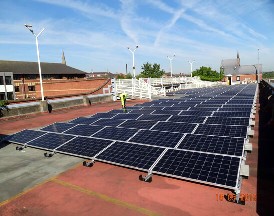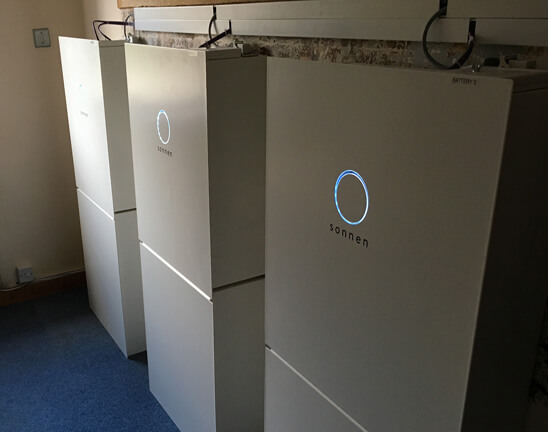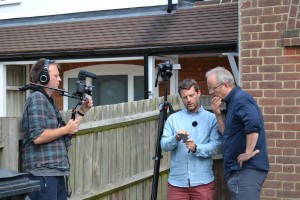ThamesWey’s Innovative Battery Microgrid
ThamesWey has recently installed an innovative solar/battery microgrid at a housing estate in Woking. ThamesWey are a private company, owned by Woking Borough Council, set up to drive carbon reductions and the wider sustainability agenda in the Borough. They own and manage over 600 properties in support of the Council’s Housing Strategy. ThamesWey offer a range of private rental properties including homes at more affordable rents and key worker accommodation. ThamesWey have a long history in the solar energy sector; back in the 2000’s, and long before feed-in tariffs were established, they were the leading institution installing solar panels in the UK. They installed their first solar panels back in 2001, and had installed over 5000 solar panels by 2012.
“It’s in our business plan to trial new technologies, so we wanted to run a demonstrator of centralised battery storage”, explains Rachel Lambert, ThamesWey’s Environmental Projects Manager. “We wanted to find a solution that saved carbon, whilst simultaneously offering a strong economic case. At the current state of technology, that required a highly innovative project”.
A Microgrid Serving 14 homes
The site chosen was a group of 14 homes, which already had solar PV installed as integrated solar roof tiles on 12 of the properties since 2010. ThamesWey built the properties to code 5 of the former Code for Sustainable Homes , and designed them to run off their own private wire network. ThamesWey import electricity into a substation, and then distribute this electricity on to the connected homes.
“We came up with a concept of installing batteries at the substation as part of our own microgrid”, said Sam Pepper, Environmental Projects Officer. “The idea was to capture the excess solar electricity that was being produced during the day, and to use this to benefit all the homes on the network, including those without solar”.
Developing a microgrid with batteries
ThamesWey asked Joju Solar to help design and implement the scheme. We undertook extensive modelling of the site, looking at ½ hourly usage and generation across the homes, and predicting what would happen if batteries were incorporated.
This was also a full financial model. ThamesWey buy in electricity that is priced every ½ hour on a real time tariff. As a ‘commercial’ user, ThamesWey also incur high additional charges of 8p/kWh (called DUoS charges) at peak times between 4pm and 7pm every weekday. We looked at the savings possible for a variety of battery models and operational regimes.
We settled on the installation of 3 x Tesla Powerwalls for a number of reasons:
- Tesla offer the cheapest storage per kWh of battery capacity
- Using 3 Powerwalls allows 40.2 kWh of electricity to be stored.
- The 3 Powerwalls can supply 15kW of instantaneous power, allowing the aggregated load of the homes to be fully covered for most of the year
- The Tesla Powerwall can be set up to import cheap, cleaner, night time electricity in winter months, adding additional savings when there isn’t excess solar available
- The Tesla Powerwall can be set up to preferentially discharge when electricity prices are high to maximise savings – in this case during the peak DUoS periods of weekday evenings. By eliminating consumption across the 14 homes in the peak period, DUoS charges become zero.
- An additional benefit of load shifting out of the peak period is that this is also when the grid is the dirtiest in terms of utilising fossil fuels.
Overall the scheme offers the best economics we have seen for behind the meter batteries, with a full return on investment within the 10 year warrantied lifetime of the Tesla Powerwall.
This centralised approach is approximately 5 times cheaper than the alternative of installing a battery in each home, showing the advantage of deploying batteries into a microgrid.
Installing a battery Microgrid
Joju installed the batteries at the substation over a 3-day period. The only issue faced with the installation was making the final connection between the batteries and the supply in the substation, which needed to be switched off to manage the works safely. Homeowners were informed in advance by letter that their supply would be briefly interrupted on the final day, and the necessary connection was made within 15 minutes.
Batteries for Sites with Landlord’s Supply
The ThamesWey project is a clear demonstrator of the strong economic case for batteries within a microgrid context in both the commerical solar panels and public sector renewables spheres. At first glance it might seem that this kind of site is fairly unique, but the same approach can be adopted wherever there is a landlord’s electricity supply in place – most commonly in blocks of flats. Any situation where the landlord buys electricity into a building (or site), and then sells on electricity to tenants, can benefit from battery storage behind the landlords meter (but in front of the tenants). It’s a model Joju Solar are now rolling out at numerous sites across the country.
Mark Rolt, ThamesWey’s Chief Executive Officer concludes “We were delighted to work with Joju Solar to install these batteries at our substation as part of an innovative trial of a centralised battery. The associated carbon savings from maximising the use of energy generated from a renewable energy technology supports our founding commitment to reduce carbon emissions in the Borough.”
Find Out More
- The Tesla Powerwall is the premium battery storage product for homes.
- Find out how behind-the-meter batteries can help you use more of your generates solar electricity
- See how else we are deploying battery storage to help homes and businesses











